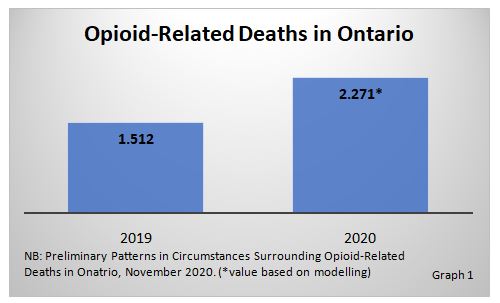TORONTO – The Covid-19 pandemic response may have some unexpected effects, for instance, a reduction in the prevalence of infl uenza. Yet, it has exacerbated a dark and deadly issue, the opioid crisis in Canada.
Communities across the nation are reeling from the unprecedented levels of drug-related deaths. Canada is in the midst of battling two public health emergencies: coronavirus and the opioid epidemic.
Tackling such an epidemic is a di€ cult task. One that requires a deeper understanding of the problem.
In 2020, the British Colombia (BC) Coroners Service reported over 1,500 deaths attributable to illicit drug use. That represents a roughly 60% increase from the 984 fatalities reported in 2019. Alarming as these numbers may be, it is not a new issue.
In 2016, BC, the epicentre of Canada’s opioid epidemic, declared a public health emergency. Since then, the province has recorded over 6,500 illicit drug toxicity deaths. On average, five people die every day from an overdose.

However, the west coast province is not the only one that is battling the crisis. Data from the Preliminary Patterns in Circumstances Surrounding Opioid-Related Deaths in Ontario during the Covid-19 Pandemic (November 2020) suggests that drug-related fatalities increased by 38.2% in the first fifteen weeks of the pandemic. On the basis of the modelling data, the anticipated tally for 2020 is 2,271 opioid-related fatalities. That represents a 50% increase from the 1,512 reported deaths in 2019 (graph 1).
To contextualize the scope of the issue, in 2020, in Ontario, 4,581 deaths were attributable to Covid-19. Drug overdoses claimed the lives of a number roughly half that amount.
Several factors drive these kinds of fatalities. For one, the Canada-US border closure disrupted drug supply chains. Consequently, there has been an increase in the circulation of the toxic supply of “street” drugs. Often times, these drugs are laced with extreme concentrations of fentanyl among other highly potent, unregulated drugs.
Also, social distancing and self-isolation measures prompt more people to use drugs alone. This reduces the chance for intervention in the event of an emergency. Pandemic restrictions have further created barriers in accessing harm reduction services and treatments.
All combined, these have the potential to increase the risk of withdrawal and rates of overdose, including mortality.
The situation is severe. Health advocates urge for more action from clinicians and all levels of government to address the multi-faceted issue affecting so many Canadians.
Dr. Dirk Huyer, Chief Coroner for Ontario said, “the report shows an increasing number of preventable opioid-related deaths during the pandemic”. As investigations continue to fi nalize the exact fi gures for 2020, the increasing trend highlights the sense of urgency.
He added, “there is a need to continue to work together to ensure adequate support and services are in place during the pandemic and beyond”.





